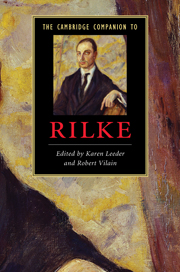4 - The New Poems
from PART II - WORKS
Published online by Cambridge University Press: 28 July 2010
Summary
New Poems, published in 1907, and New Poems: The Other Part, published in 1908, together constitute the first of the four major works on which Rilke's reputation rests. We follow Rilke in using the shorthand New Poems to speak of both volumes as a unit, since, notwithstanding differences between the two volumes, they are parts of a single poetic project. Readers have generally agreed with Rilke that these 189 poems (under 172 titles, nine announcing sequences), written mostly in Paris between 1903 and 1908, are something 'new' in his work. Strongly influenced by the example of the sculptor Auguste Rodin, whose secretary Rilke was from September 1905 to May 1906 and on whose work he had written and lectured, Rilke turned in the New Poems to a sharp focus on the individual poem as a crafted and freestanding structure. The resulting poems have often been called 'made things', the more so because the most famous of them are also about individual objects, and although we shall have to emphasise other, sometimes countervailing, aspects of the poems as well, it is not hard to see the reasons for this description.
Taken as a collection of self-sufficient things, the New Poems have been characterised as a museum. All but a handful of the 172 titles could very easily be the names of paintings or sculptures. Some are the names of paintings or sculptures: ‘Early Apollo’, ‘Cretan Artemis’, the three Buddha poems, ‘L’Ange duMéridien’, ‘Portrait of My Father as a Young Man’, ‘Self-Portrait 1906’, ‘Archaic Torso of Apollo’, ‘Lady Before the Mirror’.
- Type
- Chapter
- Information
- The Cambridge Companion to Rilke , pp. 59 - 73Publisher: Cambridge University PressPrint publication year: 2010
- 1
- Cited by



